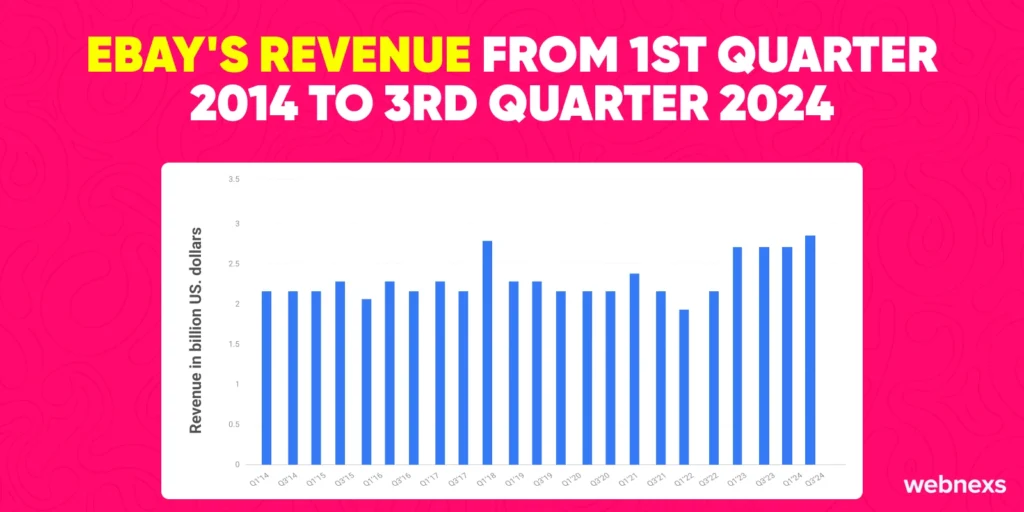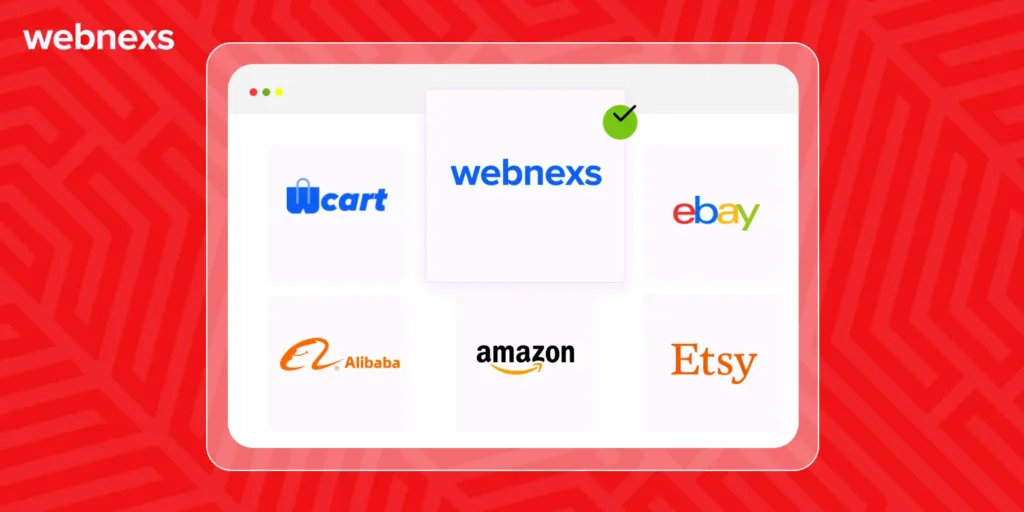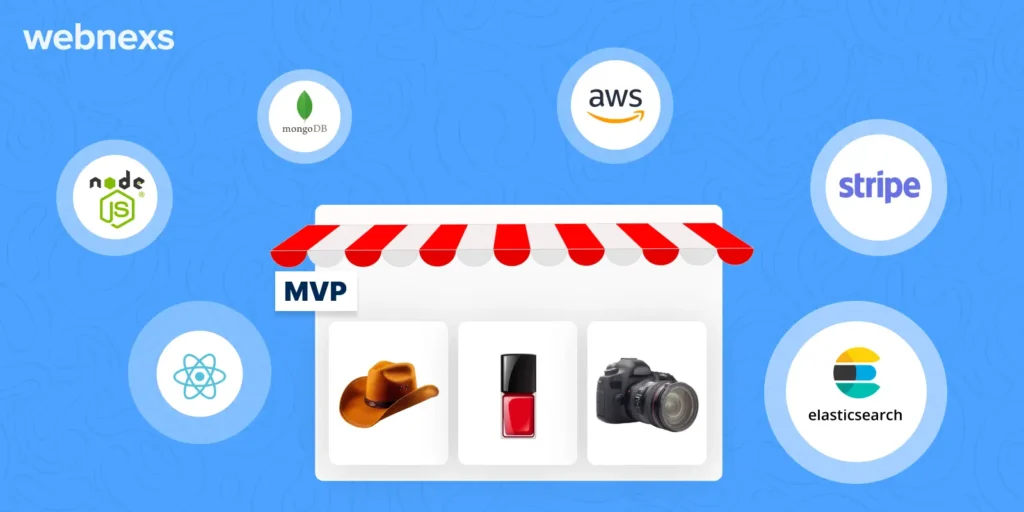What’s up, readers?
eBay is a major online marketplace that attracts about 1.2 billion monthly visits. As of April 2024, its market value was $26.52 billion, placing it among the world’s top 1,000 most valuable companies.
Online shopping is easier than ever, and eBay is one of the biggest platforms.
It’s a well-known marketplace where people buy and sell various products. But building a web like eBay isn’t easy; it takes planning, research, and ongoing work.
If you’re wondering how to build a website like eBay, this guide will help. We’ll go over the key steps, important features, and things to consider. You’ll also get an idea of the costs involved so you know what to expect.
Key Takeaways on Build Website like eBay
- To learn how to build a website like eBay, identify a unique marketplace idea that addresses gaps in the market, such as high fees or inadequate buyer protections, to create a platform that meets real user needs.
- When you create a website like eBay, select the right business model that ensures long-term profitability, such as commission-based sales or subscription fees.
- To build a website like eBay, start small by launching a simple version of the site with just the essential features. This lets you get the site up and running quickly while gathering real feedback from users, helping you improve along the way.
- When attracting sellers, offer competitive fees and highlight why your marketplace is a great place for them to be. Make it easy for them to list and manage products, so they don’t feel overwhelmed as they get started.
- As you improve the site, stay focused on what your users need and keep making adjustments. Once you’ve got a solid base and a good fit with your audience, consider expanding to other regions and adding more product categories to keep growing your marketplace.
Are you Looking to Build a Website like eBay?
Why build a website like eBay?
Online marketplaces are growing quickly and are now one of the most popular ways to shop online. In 2023, they made up more than a third of all online shopping orders.
This growth is expected to continue, and by 2027, online marketplaces will be the largest and fastest-growing way people shop.
This also means more competition, especially from smaller platforms that focus on specific interests or niches. If you’ve thought about how to create a marketplace like eBay, now is a great time to start.
Building a marketplace like eBay is easier than before, and you don’t need a big team or lots of money. Here’s why:
- No inventory needed: You don’t have to store products. Instead, you connect buyers with sellers who manage their items.
- It’s easy to start: Tools like Sharetribe let you build a marketplace quickly, even if you don’t know how to code. You can have a site up and running in one day.
- Test and improve: You can launch fast, get feedback from users, and make changes without spending a lot of money.
Starting an online marketplace is now easier than when eBay first began. This guide will show you how to do it.
What is eBay all about
Let’s explain what eBay is. eBay is an online platform where buyers and sellers can meet to buy and sell products. It works for both businesses and individuals, so anyone can list their items for sale, and anyone can shop.
eBay offers two ways to buy items:
- Fixed Price
- Auction.
Fixed Price – The fixed price option is like shopping in a regular online store, where the price is already set.
Auction – The auction option is different. Sellers set a starting price, and buyers can place bids. The item goes to the person who offers the highest bid when the auction ends.

eBay is one of the most popular and successful auction websites. Research from Statista shows that eBay has not only been profitable but has also consistently generated high revenue over the years.
Build a Website Like eBay: A Step-by-Step Guide in 10 Steps

At Webnexs, we’ve helped countless entrepreneurs bring their marketplace ideas to life. Based on our extensive experience, building a website like eBay involves 10 key steps. Let’s dive into the process and show you how to get started on your own marketplace platform.
1. Identify a Strong Marketplace Idea
2. Choose the Right Marketplace Business Model
3. Start with a Focused Scope
4. Pre-Validate Your Marketplace Idea
5. Build a Marketplace Platform with an MVP
6. Onboard Your First Sellers
7. Launch Your Marketplace
8. Reach Problem-Solution Fit
9. Reach Product-Market Fit
10. Scale into New Markets
Next, we’ll go over these 10 steps specifically for building a website like eBay.
For more information and extra resources, take a look at our complete guide on creating a marketplace.
Step-by-Step Guide to Create a Website Like eBay.
1. Identify a Strong Marketplace Idea

If you’re thinking about building a marketplace or other website like eBay, the first thing you need to do is come up with ideas that address real problems people face.
These are the types of ideas that tend to be successful. eBay saw an opportunity to create a platform where people could easily buy and sell products globally, whether they were casual sellers or established businesses.
Here’s how you can get started:
1. Look for Gaps in the Market
Start by looking at other online marketplaces like eBay, Amazon, and Alibaba. See if there are any areas where these platforms fall short, like counterfeit products, high fees, or bad customer service. These are the areas where you can make improvements.
By focusing on fixing these issues, you could create a better option for buyers and sellers.
For example, eBay had problems with fake listings and fraud in the beginning. If you can solve these issues, you’ll be able to carve out your own space in the marketplace world.
2. Pay Attention to What People Are Saying
Online communities like Reddit, Quora, or industry-specific forums are great places to hear from people about their frustrations with eBay or what they wish could be improved. These platforms can give you valuable insights into what users want in a marketplace.
For instance, many people complain about eBay’s high fees or lack of strong buyer protection. By listening to these complaints, you can create a platform with better customer service, lower fees, or stronger protections that make users feel safer.
3. Find Your Unique Selling Point
To stand out from eBay and other platforms, you need to figure out what makes your marketplace unique.
Maybe you’ll focus on offering better seller verification to avoid counterfeit products or make the platform easier to use. Your unique selling point (USP) will help set your site apart from others.
By addressing the issues others aren’t tackling, you can build a platform that attracts people looking for a better experience, and position your marketplace as a trusted option.
2. Choose the Right Marketplace Business Model Sites Similar to eBay

Building a web like eBay requires selecting the right business model that suits your platform’s long-term vision like Webnexs, Wcart, and more.
The business model of a marketplace determines how revenue is generated and the platform’s sustainability. eBay initially charged membership fees and later diversified its approach with a hybrid revenue model.
1. Commission-Based Model
eBay charges sellers a commission of 10%-12% per sale, making it a profitable, low-risk model. This transaction-based structure aligns the platform’s revenue with its success, as sellers only pay when they make a sale creating a scalable revenue model.
2. Subscription Fees
The platform offers premium memberships for sellers, providing additional benefits such as enhanced visibility, advanced analytics, or priority customer support.
Buyers can also pay for memberships that grant access to exclusive deals or faster shipping.
3. Advertising Revenue
eBay allows sellers to pay for better visibility in search results, a feature that works particularly well in competitive marketplaces.
Once sellers gain traction, they can invest in featured listings, banner ads, or product boosts to further increase exposure. This approach can become a significant revenue driver for the platform.
4. Lead Generation Fees
Charging for lead generation is particularly useful in B2B marketplaces, where securing large contracts holds significant value.
Evaluating the strengths and weaknesses of each model based on the target audience and niche is essential.
One feasible strategy includes attracting users by offering a mix of revenue streams or starting with a low-cost model before expanding into more premium options.
3. Start with a Focused Scope

It might be tempting to jump in and try to do everything at once, especially if you’re aiming to build a big platform like eBay. But it’s better not to get ahead of yourself and try to do too much too soon.
When eBay first started back in 1995, it was a very simple website. It was just a place where buyers and sellers could meet to auction collectibles and other items.
Pierre Omidyar, eBay’s founder, was the first person to list something like a broken laser printer for just $1. For an entire week, no one was interested in buying it.
Then, little by little, bidders started showing up, and the price of the printer eventually rose to $14.83. That’s when Omidyar realized he might be onto something.
As the site gained traction, eBay focused on building trust with its users and improving the core experience.
Once they had a solid foundation, they started adding more features, like auctions for travel-related products such as hotel rooms and flights. Instead of rushing, they grew step by step, which helped them avoid spreading themselves too thin.
This slow and steady approach is something we’ve seen work time and time again with the marketplace founders we’ve worked with at Webnexs.
4. Pre-Validate Your Marketplace Idea

Before you fully invest in building a website like eBay, a feasibility and viability study must be done to avoid costly mistakes by ensuring that there is demand for the idea through the following methods:
1. Engage with Potential Sellers and Buyers
Direct contact with the target audience through surveys, interviews, or focus groups is essential to gather feedback on the proposed platform.
The questionnaire should include questions about their requirements, frustrations with current solutions, and their likelihood of using a marketplace like yours.
2. Create a Landing Page
The landing page must be designed to clearly outline the marketplace’s value proposition.
By allowing users to sign up for early access or updates, you can gauge the interest of the target audience. This approach serves as a preliminary validation of market demand.
3. Leverage Social Media
Using social media platforms to share marketplace ideas and gather comments will elicit candid feedback on the concept’s feasibility.
Pre-validating the idea will refine the marketplace’s features and approach, ensuring it meets real needs before committing significant resources to development.
5. Build a Marketplace Platform with an MVP Similar to Sights Like eBay

Tech Stack Options for an eBay-like Marketplace
| Component | Recommended Technology |
| Frontend | Next.js, React, Vue.js |
| Backend | Node.js, Django, Ruby on Rails |
| Database | PostgreSQL, MongoDB |
| Hosting | AWS, Google Cloud, Vercel |
| Payment Gateway | Stripe, PayPal, Adyen, Crypto payments |
| Search & Filtering | Algolia, Elasticsearch |
Starting your marketplace platform with a Minimum Viable Product (MVP) is the best way to enter the market quickly. An MVP allows the launching of a functional platform with only the most essential features:
1. Core Features
The focus must be on the key components necessary to facilitate transactions like user registration, product listings, search functionality, secure payments, and seller-buyer messaging.
2. Use Lean Development Techniques
Headless ecommerce platforms such as Webnexs, Wcart, or Shopify offer pre-built frameworks that save development time. By integrating these tools, creating a fully functional MVP faster allows gathering feedback early.
3. Iterate Quickly
Insights must be gathered to continuously refine the platform. Early adopters provide invaluable feedback on usability, navigation, and missing features.
Learn How to Make a Website Like eBay Today
6. Onboard Your First Sellers

Your MVP is ready, but how do you get sellers without customers and customers without sellers? This is a problem most new marketplaces face.
When eBay started, its founder, Pierre Omidyar, didn’t have a clear plan. He just put his broken laser printer up for auction, which brought in buyers. The key takeaway here is that starting with a good supply of products is often the best move.
Without enough sellers, you won’t have enough products to attract buyers.
Here are some ways to build your seller base:
- Like Pierre Omidyar, you can start by being a seller yourself.
- Attend local events and meetups to connect with sellers.
- Join online communities or forums where sellers gather.
- Reach out to sellers directly.
- In the beginning, you can “fake” your product supply by copying listings from other websites or manually collecting products that might interest buyers.
If you’re active in online groups related to your marketplace, you might find sellers who are unhappy with platforms like eBay and are looking for something new.
To convince sellers to join even before you have buyers, you can:
- Offer lower fees and commissions than eBay.
- Give discounts or special deals for early sellers.
- Show them the potential to reach the right buyers.
- Explain how they can build their brand and customer relationships.
- Provide better tools for managing listings and inventory (many users complain that eBay is too complicated.
In short, if you bring in enough sellers to list products on your platform, the buyers will follow.
7. Launch Your Marketplace

This is the stage where you need to bring your first sellers some buyers. When you launch, it’s better to start with a small, carefully chosen group of people (a beta audience) instead of going public right away.
This way, you can test how your platform works, get important feedback from real users and make any necessary changes before you open it up to a wider audience.
The quicker you launch, the sooner you’ll know if your eBay-like marketplace has real potential.
Read More: How To Launch a Marketplace | Best 8 Strategies To Promote
Here are some ideas for finding your first customers:
- Ask your sellers. If they’ve sold on platforms like eBay before, they may already know how to bring in buyers.
- Look for active online forums, Facebook groups, or subreddits that are related to your marketplace.
- Go to local events, clubs, or meetups where your potential customers might be.
- Run a small paid ad to attract interested people.
If you can prove to buyers that your platform offers better value (like higher-quality products) than others, you’ll have a strong reason for them to choose you.
Launch your Website Like eBay with These Simple Steps Today.
8. Reach Problem-Solution Fit

Getting both buyers and sellers on your platform is a big achievement, but it’s just the beginning. The next step is finding a “problem-solution fit.”
This means your platform should be solving the problems and meeting the needs of both buyers and sellers.
At this stage, your marketplace should:
- Help complete transactions regularly.
- Show signs of revenue potential (it might not be profits yet, but you should see promise).
However, sometimes even if you have users on your platform, you might not see any transactions happening. This can be frustrating but don’t worry. It’s time to make changes.
A good way to start is by reaching out to your users and asking what’s going wrong:
- Did they understand the purpose of your platform? If not, think about how you explain what you offer.
- Did you have the products buyers wanted? Maybe you need more suppliers.
- Were they having trouble finding what they needed? You might need to rethink how things are organized.
- If there are a lot of abandoned transactions or shopping carts, consider changing how the buying process works or adjusting your prices. Maybe a simple “buy now” button would work better than a complicated multi-vendor cart.
It’s tempting to try to grow quickly, but don’t rush. Focus on getting the basics right make sure your platform works well and users have a good experience before trying to scale.
Even eBay took time to experiment and learn from customer feedback before it became a leader in the market.
Most marketplaces don’t become popular overnight, so don’t get discouraged if things start slow. Instead, use this time to figure out which features and channels are truly working for your users.
9. Reach Product-Market Fit

Product-market fit happens when people want what you’re offering, users are enjoying your platform, and you’re making money.
If you’re building a big marketplace like eBay, you’ll probably need outside funding. This is the time to focus on creating a plan to grow and reach new markets.
eBay grew quickly. By 1996, just a year after it started, it was already making millions. The company got $6.7 million in funding and went public in 1998.
Today, investors want to see that you can make a profit and grow steadily. To get their attention, you need to prove that your marketplace works and has a clear plan to expand.
To know if you’re on the right track, look at things like how often people make transactions repeat business, and how much it costs to get new customers.
Focus on SEO, viral marketing, and reaching out to both buyers and sellers to grow. You might also need to improve your platform’s features and user experience at this stage.
10. Scale into New Markets

1. Expand Geographically
Expand to new regions, focusing on areas where the initial concept has proven successful. Localizing the platform by offering language support, regional payment methods, and currency conversions is key.
2. Add New Categories
Introduce additional product categories or services, leveraging existing user base to support the new offerings.
3. Build Strategic Partnerships
Form alliances with logistics companies, payment gateways, and other service providers to ensure smooth operations as scaling is done.
What Makes eBay So Successful?
eBay’s success is backed by impressive numbers. As of 2024, eBay has 135 million active buyers and generates over $9.8 billion in annual revenue. The platform processes over 1.5 billion listings at any time, showing its vast product variety.
eBay vs Competitors: While Amazon dominates with its inventory-based model, eBay thrives on a peer-to-peer model where individual sellers list products. Unlike Etsy (handmade focus) or Walmart Marketplace (retail-heavy), eBay attracts auction-based buyers looking for deals.
Global Marketplace: eBay lets people from all over the world buy and sell things. This means you can find items that aren’t available in your local stores.
Buyer and Seller Protections: eBay helps protect both buyers and sellers. If there’s a problem, the Money Back Guarantee makes sure buyers get their money back, while sellers have ways to resolve issues.
User-Friendly Tools for Sellers: eBay gives sellers easy tools to list products, manage their sales, and track how they’re doing. This helps both beginners and experienced sellers succeed.
Reputation System: eBay’s feedback system allows buyers and sellers to rate each other. Good ratings build trust, while bad ratings help people know when they might face issues.
Build and Launch your Website Like eBay with Ease Today
5 Key Considerations To Develop A Profitable Marketplace Platform – Web like eBay

To run a smooth and profitable ecommerce business website, an effective infrastructure must be in place from the inception of the site.
Also, important features of store design attract more customers while keeping the existing customers happy with your service.
1. User Interface
Having an interactive and user-friendly website is important so that your customers can easily find the product they’re looking for.
While it will help in bringing traffic to your ecommerce website, the user interface also plays a major part if you plan to expand to mobile platforms shortly.
2. Support
A quick and dedicated CRM team will prove to be of advantage while addressing the queries and concerns of customers, especially when dealing with wholesale orders.
Whether it’s a matter of late delivery or a faulty product, a prompt and assured response should be made to the customer.
3. Security
A customer would need to share their personal information like bank account details for payment procedures, and not only do you have to establish a secure website, but you also need to ensure the clients feel secure as it helps in building trust and confidence.
Secure payment methods are a key factor when building shopping sites like eBay.
4. Logistics
Logistics is an important pillar of operations in an ecommerce website. Choose operators with a good track record and extraordinary last-mile delivery.
5. Product Data
The products on your website must have enough product data. This includes adequate product descriptions and specifications in the need of text, images, and if the demand for the product, then a demo video.
If sellers fail to provide enough data for their product, it’s still your responsibility to furnish enough information about the product on your website.
Besides these key features, creating a marketplace like eBay also means following some legal rules to ensure everything runs smoothly and safely.
1. Payment Security & Fraud Prevention
- Use secure payment options like PayPal or Stripe to protect transactions.
- Make sure you follow fraud prevention steps, like confirming the identity of buyers (KYC verification), to protect both sellers and buyers.
2. Tax Regulations & Compliance
- Be sure to understand and follow the tax rules in your country and other countries where you sell. For example, eBay collects sales tax in over 45 U.S. states to follow local laws.
- If you sell internationally, you’ll need to research tax rules like VAT or GST in those countries to stay compliant.
3. User Data Protection (GDPR & CCPA)
- Protect your users’ data by following privacy laws, such as the GDPR (for Europe) or CCPA (for California).
- Let customers delete their data if they want to, as required by these laws.
Why choose Webnexs for building a website like eBay
Choosing Webnexs to build a website like eBay makes a lot of sense because they know how to create custom online stores.
They’ve worked with marketplaces before, so they understand the challenges of managing multiple sellers, secure payments, product listings, and customer accounts.
Webnexs offers a lot of flexibility, allowing you to build a platform that matches your business, whether you need auction features, payment systems, or an advanced search.
They also make sure the platform can grow with your business, handling more traffic and transactions as you expand. Plus, their designs are simple to use and work well across all devices, so your customers have a smooth experience.
Create Your Own Web Like eBay Today and Start Building a Successful Platform Right Now!
Conclusion
Got a big idea that could compete with eBay? Many businesses create websites similar to eBay because they attract a lot of visitors, drive strong sales, and generate good profits.
At Webnexs, we’ve helped many online marketplaces grow and succeed. If you’re wondering how to build a website like eBay, we’re here to help you build yours.
Check out our work, book a consultation, and let us help you launch your marketplace smoothly.
Contact us today to get started!






5 Responses
E commerce business will have significant growth in the future, and making a website like eBay is not an easy task. However, this post provides vast information about how to make a website like eBay with a perfect marketplace.
I’m having a retail shop in the UAE and recently I’m trying to move into the eCommerce market. Since I’m new to this industry, I’ve been doing a lot of research about creating an eCommerce marketplace website, especially how sites like eBay operate. I find this blog very useful. Can you help further in developing my own eCommerce website? Thanks in advance!
Hi Syed, I’m glad you found this article useful. Sure, we can help you build a website like eBay and develop an eCommerce marketplace for your retail business.
For instant response make use of our live chat feature
or leave us a mail at sales@webnexs.com
This post gives me a complete breakdown of how to make a website like eBay. a ready-made eCommerce script is a wise choice for building an online store successfully.
Thanks for providing such a useful blog. I have learned the entire process of how to create a website like eBay. My future plan is to develop an e-commerce website and achieve success.